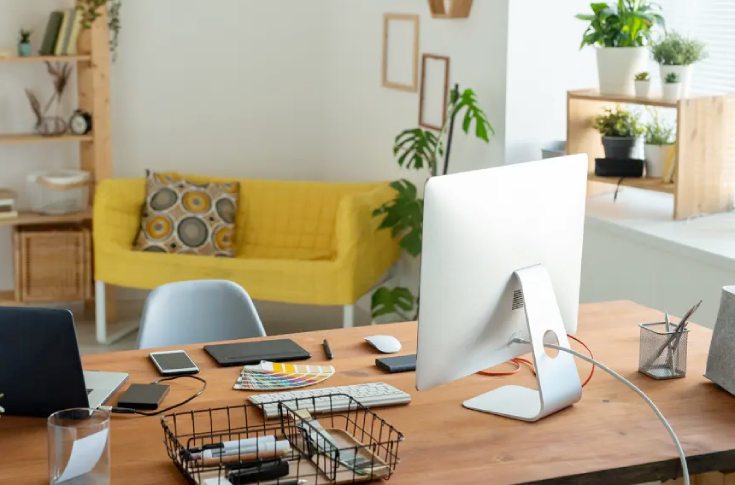In the evolving landscape of work, where the boundaries between home and office have become increasingly fluid, creating a functional and inspiring home workspace has never been more crucial.
Whether you’re a seasoned remote worker or new to the concept, understanding the fundamentals of home office design can make a significant difference in your productivity, comfort, and overall well-being.
In this comprehensive guide, we’ll delve into the essential elements of designing your ideal home office, from regulating desk height and selecting the right chair to harnessing the greenery of a desk plant.
The Right Desk Height: The Foundation of Productivity
Your desk is the epicentre of your home office design, and its height plays a pivotal role in your comfort and productivity. An improperly positioned desk can lead to discomfort, fatigue, and even long-term health issues. Here’s how to find the perfect desk height:
- Measure Your Elbow Height
While seated with your feet flat on the floor, measure from the floor to your elbow. This measurement is a good starting point for your desk height;
- Maintain a 90-Degree Angle
Your elbows should form a 90-degree angle when typing. Adjust the desk height to achieve this angle, ensuring that your wrists remain straight as you type;
- Ergonomic Accessories
If your desk is not adjustable, consider using an ergonomic keyboard tray or an adjustable monitor stand to achieve the ideal typing and viewing height;
- Sit-Stand Desks
If you have the space and budget, sit-stand desks offer flexibility. They allow you to switch between sitting and standing, promoting better posture and reducing the risks associated with prolonged sitting;
Selecting the Perfect Chair: Your Throne of Comfort
Your choice of chair can make or break your home office experience. An ergonomic chair designed to support your body’s natural alignment is essential for comfort and productivity. Here’s what to consider:
- Lumbar Support:
Look for a chair with proper lumbar support. This helps maintain the natural curve of your lower back and reduces the risk of back pain.
- Adjustable Features:
Opt for a chair with adjustable features such as seat height, armrests, and tilt. These allow you to customise the chair to your body’s unique needs;
- Breathable Material:
Choose a chair with breathable upholstery to prevent discomfort caused by heat and moisture buildup;
- Seat Depth:
Ensure that the chair’s seat depth accommodates your legs comfortably. Your feet should rest flat on the floor or on a footrest, with a slight gap between the edge of the seat and your knees;
- Test Before You Buy:
Whenever possible, test chairs in person to gauge their comfort and fit. Remember that what works for one person may not work for another, so prioritise your own comfort.
Harnessing the Green Power of Desk Plants
Beyond ergonomic considerations, the aesthetics and ambiance of your home office can have a profound impact on your mood and productivity and this is why they are so important when it comes to home office design ideas.
Introducing a desk plant into your workspace can breathe life, colour, and positivity into your daily routine. Here’s why desk plants are a must:
- You Enjoy Better Air Quality
Certain plants, like snake plants and peace lilies, act as natural air purifiers, removing toxins and improving indoor air quality. This can boost your focus and overall well-being;
- Plants Help for Stress Reduction
Studies have shown that the presence of plants can reduce stress and anxiety levels. Their calming effect can enhance your concentration and creativity;
- Aesthetic Appeal
Plants add a touch of nature’s beauty to your workspace, making it a more inviting and visually pleasing environment;
- Productivity Boost
The sight of greenery can have a positive impact on your cognitive function and problem-solving abilities, potentially enhancing your productivity;
- Low Maintenance
Many desk plants, such as succulents and pothos, are low-maintenance and require minimal care. Even if you’re not a green thumb, you can still enjoy the benefits of a desk plant;
Additional Tips for a Well-Rounded Home Office Design
Crafting the ideal home office involves a harmonious blend of ergonomics, aesthetics, and personalization. Here are a few more tips how to add a final touch to your home office design:
- Natural Light
Position your desk near a window to benefit from natural light during the day. Natural light can reduce eye strain and boost mood;
- Task Lighting
Invest in task lighting, such as a desk lamp with adjustable brightness, to ensure proper illumination for your work tasks;
- Cable Management
Keep cables organised and out of sight using cable organisers, clips, or sleeves to maintain a clean and clutter-free workspace;
- Personalization
Add personal touches like artwork, family photos, or decor items that inspire you and make the space uniquely yours;
- Organisation
Utilise shelves, filing systems, or digital tools to keep documents and supplies organised and easily accessible;
- Comfort Accessories
Consider ergonomic accessories like a keyboard tray, monitor stand, or footrest to further enhance your workspace’s comfort and functionality.
By considering these recommendations and incorporating the additional tips for a well-rounded home office design, you can create a workspace that not only promotes productivity but also enhances your overall work-from-home experience.

My name is Scarlett Mitchell and i am an author and editor in the home topic website – FemCasa.com.
I’m just an enthusiast who wants to share her visions, ideas and advices, when it comes to decorating every part of your home until it becomes the perfect relaxing place for you and your family.

